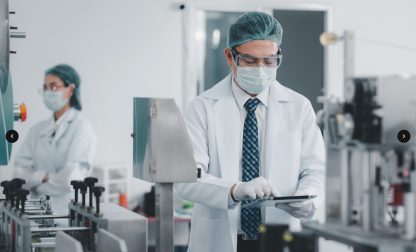The 5 fields of robotics

Robotics are taking center stage across diverse industries, revolutionizing the way tasks are accomplished. This rapid progression is based on the continuous progress in distinct areas of robotics, each being one puzzle piece in the bigger picture of robotics.
In this article, we delve into five key fields that define robotics:
- Design of operator interfaces
- Transport and locomotion
- Interaction with the environment
- Precise execution through programming
- Gathering of information1
1. Designing operator interfaces for different areas
Operator interfaces act as the bridge between human operators and advanced automation systems. In designing these interfaces, customization emerges as a cornerstone, tailoring solutions to the specific needs of diverse industries.
Usability and adaptability become focal points, ensuring that operators can seamlessly interact with and control robotic systems across various applications. The challenge lies in creating interfaces that not only meet industry-specific requirements but also enhance overall efficiency. This involves striking a balance between intuitive design and specialized functionalities to empower operators in their varied tasks.

2. Transport and locomotion
Precision and speed are paramount in logistics, making robotic efficiency crucial in optimizing the movement of various goods. Industries integrate robotics into manufacturing, enhancing processes and material handling for heightened operational excellence. In warehouses, autonomous vehicles redefine logistic processes, requiring robots to be not only mobile, but reliable and safe.
Developing such robots demands a fusion of advanced sensors for environmental awareness and responsive systems to navigate diverse terrains. Safety features play a significant role as well, allowing mobile robots to operate in the presence of humans as well.
3. Interaction with the environment
The design of manipulators and effectors holds paramount importance in enabling seamless interaction with the environment. These components serve as the hands and tools of robots, allowing them to grasp, manipulate, and interact with objects in their surroundings. Efficient manipulator design involves crafting robotic arms and end-effectors with precision and versatility.
Manipulators must be capable of performing a wide range of tasks, from delicate and precise movements in controlled environments to robust and forceful actions in dynamic settings. Advanced kinematics and materials play a crucial role in ensuring optimal performance and adaptability.
Similarly, effector design focuses on creating specialized tools and attachments that enhance the capabilities of robotic manipulators. Grippers, suction cups, and specialized sensors are just a few examples of effectors designed to facilitate specific interactions with the environment. Each effector is meticulously engineered to optimize grip strength, dexterity, and sensitivity, allowing robots to handle a diverse range of objects and materials with ease.
4. Precise execution of commands
Achieving precision in executing commands hinges on the adequate programming of robots. The essence lies in crafting code that not only dictates specific actions but also accommodates dynamic adjustments. Flexible programming becomes indispensable, allowing quick modifications to settings, parameters, and task sequences.
This adaptability proves crucial in environments where tasks are subject to frequent changes. From intricate assembly lines in the pharmaceutical industry to unpredictable research scenarios, the ability to tweak and fine-tune programming ensures robots can seamlessly adapt to evolving requirements. Innovative solutions, as they are developed by ESSERT Robotics, therefore allow a quick and intuitive customization of manufacturing processes, with no need for programming skills.
5. Gathering of information
The robotic gathering of information relies on a sophisticated array of sensors and technologies that act as the eyes and ears of machines. Vision sensors, such as cameras and LiDAR (Light Detection and Ranging), provide crucial visual data for navigation and object recognition. Tactile sensors enable robots to sense and respond to physical contact, enhancing safety and dexterity.
Advanced environmental sensors, like infrared and ultrasonic sensors, contribute to spatial awareness. Furthermore, technologies such as GPS (Global Positioning System) and RFID (Radio-Frequency Identification) facilitate precise location tracking.
The synergy of these sensors creates a comprehensive data landscape. This allows robots to gather, process, and respond to information from their surroundings with unparalleled accuracy.

Prospects: What robotics is currently focussing on
Progress in robotics is far from being over. Instead, research and progress is being made in several aspects, aiming to improve robots to make them feasible for even more applications, in an optimized manner:
- AI integration: Robotics is increasingly integrating advanced artificial intelligence algorithms, empowering machines with enhanced decision-making capabilities and adaptability.
- Human-robot collaboration: The focus extends to developing cobots capable of collaborative work with humans, blurring the lines between manual and automated tasks for increased efficiency.
- Sensory advancements: Ongoing research aims to enhance sensor technologies, expanding the spectrum of data robots can gather from their environments for more informed decision-making.
- Autonomous and modular systems: Robotics is gravitating towards achieving greater autonomy, enabling machines to operate with minimal human intervention in diverse and complex scenarios by relying on modular and flexible designs.
- Ethical considerations: As robots become more integrated into daily life, there is a growing emphasis on addressing ethical considerations, e.g. ensuring responsible AI usage, and mitigating potential societal impacts.
Scalability and flexibility powered by ESSERT Robotics
ESSERT Robotics pioneers scalability and flexibility in manufacturing with its modular solutions. The ADVANCED Robotic Workstation and MicroFactory epitomize adaptability, catering to the changing needs and circumstances in modern production environments.
Featuring a modular architecture, these systems seamlessly integrate diverse robotic workstation modules, enabling customizable and scalable production lines. Specifically designed for High Mix / Low Volume (HMLV) production, the ADVANCED Robotic Workstation excels in handling varied product batches.
The ESSERT MicroFactory offers unparalleled flexibility in composition, allowing users to define custom production processes by combining several ADVANCED Robotic Workstations. ESSERT Robotics ensures easy integration and future-proof adaptability, empowering industries to stay agile in a rapidly evolving market landscape.
Read more about robotics
Robots in manufacturing: revolutionizing production processes
Robotic manufacturing companies
Cobot – all you need to know about collaborative robots
What is an industrial robot?
Robotics in the pharmaceutical industry
Robotics – 7 facts you need to know
- https://roboticsandautomationnews.com/2022/12/28/the-major-fields-of-robotics-in-2023/58882/ ↩︎











